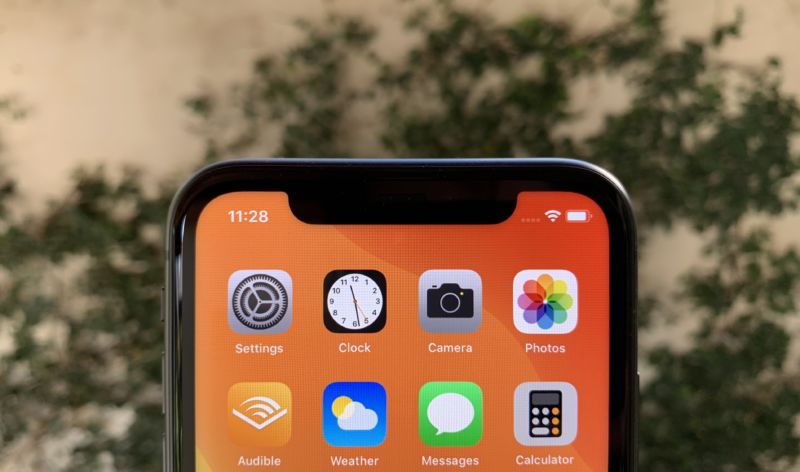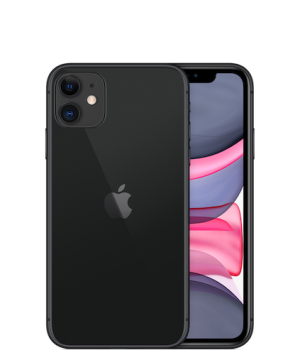
Samuel Axon
Apple's iPhone lineup today is stacked with great phones at varying price points, though. So where does the iPhone 11 fit in?Like the iPhone XR before it, the iPhone 11 is the default iPhone. It's priced where flagship phones used to be priced, and it offers almost all the same features as the expensive iPhone 11 Pro models that also launched this year.
That's what we'll be looking to answer in this review. And we're dubbing this a mini-review because we recently published an in-depth article on the iPhone 11 Pro and 11 Pro Max, and last year we published a full review of the iPhone XR. This year's changes from the iPhone XR to the iPhone 11 are quite modest, so today we'll focus on how this phone is different from this year's flagships and its direct predecessor.
As always, let's start with the specs.
Table of Contents
Specifications
The iPhone 11 measures 5.94 x 2.98 x 0.33 inches (150.9 x 75.7 x 8.4mm), and has a 6.1-inch (154.9mm) LCD display with a resolution of 1,792 x 828, a typical contrast ratio of 1,400:1, and a maximum brightness of 625 nits. The phone comes in 64GB, 128GB, and 256GB storage configurations at $699, $749, and $849, respectively.
Apple has included its A13 system-on-a-chip, which includes numerous components: a central processing unit, a graphics processing unit, an image signal processor, the Neural Engine for machine learning, and a bunch more. Apple claims that almost all aspects of the A13 are 20% faster than what we saw in the A12 that appeared in last year's iPhone XR.
Apple iPhone 11
On the wireless front, we've got a claim of gigabit LTE, plus Wi-Fi 6 and Bluetooth 5.0. The iPhone 11 also has the U1 chip we discussed in our iPhone 11 Pro review; this chip makes the phone location-aware in relation to other wireless devices nearby. Right now, the only feature that taps this is the ability to AirDrop files to another recent iPhone by physically orienting your iPhone 11 toward the target device. But there will likely be more uses for this chip in the future.
Apple has introduced spatial audio for the iPhone this year. It provides a fuller, deeper sound field than before, with Dolby Atmos support. You'll still probably want to use headphones, but it's a huge improvement over the XR's sound system.
We'll go over camera specs in the camera section of the review, since photography is a key focus of this update—in fact, the camera system is one of the only things that's substantially different from the iPhone XR we reviewed last year.
Design
Everything about the iPhone 11 looks identical to the iPhone XR except for two things: the camera system on the back, and new color options.
Colors include red, yellow, black, white, purple, and green—many of which have an almost '90s-throwback light shade to them. Our review unit is the classic black. Like the XR, the iPhone 11 has a glossy glass back that loves to attract fingerprints as quickly and as prolifically as possible. The iPhone 11 Pro phones that we reviewed earlier this week have a new, matte finish for the back that is a little less prone to that problem—though they are still made of glass.
-
The iPhone 11.
Samuel Axon
-
The back of the phone still has a glossy glass appearance, like its predecessor.
Samuel Axon
-
It still has a Lightning port.
Samuel Axon
-
The volume control side is the same...
Samuel Axon
-
...as is the SIM tray side.
Samuel Axon
-
The top remains featureless.
Samuel Axon
-
The odd-looking camera system on the back.
Samuel Axon
-
From left to right: iPhone 11, iPhone 11 Pro, iPhone 11 Pro Max.
Samuel Axon
-
Another view of the three phones side-by-side (same arrangement).
Samuel Axon
Apple says the iPhone 11's glass back is more durable than what we got in last year's phones. But it's still glass, even if that glass is particularly strong, and damage from a drop onto a hard surface like concrete remains a risk. These phones are nigh-impossible for a user to repair should a break like that occur, and because of the way they're made, repairs from an Apple-certified repair shop or the Apple Store involve replacing huge portions of the phone to fix some pretty basic things. So you're looking at high repair costs if you don't also spring for AppleCare+.
The iPhone 11 also sports water resistance at up to two meters of depth for up to 30 minutes, another improvement over the XR.
The camera on the back has a completely new look. Whereas the iPhone XR had one camera, this one has two: a wide-angle (returning) and an ultra-wide-angle (new). The two lenses are aligned vertically and placed inside of a large-ish, rounded square of glass protruding from the back of the phone ever-so-slightly. Apple is keen to point out that both the camera bump and the rest of the back are "precision-milled from a single sheet of glass," and the glass does look handsome when you're up close.
That said, I personally feel the camera bump itself looks weird on the iPhone 11—moreso than in the Pro models. I think it's because the two lenses only occupy half of the square-shaped bump, and while there are a couple other components on the other side (like the flash), it looks lopsided and seems like it might not have been necessary have this entire square in place. Something more like what we saw with the two-camera systems in the iPhone X and XS phones would have looked a little more graceful.I also feel that the iPhone XR is just kind of bulky. It's not a very elegant-looking device; it's price over form here, with a lot of tiny compromises to bring the costs down but actually add up in terms of aesthetic experience. Of course, that sort of thing is subjective, and it's also not really that important in the grand scheme.
Other than these notes, the iPhone 11 looks identical to the iPhone XR, the design of which we talked about at length in our review last year.
Camera
The biggest changes the iPhone 11 introduces over the iPhone XR are in the various cameras on the device. On the back, we have two 12-megapixel cameras, up from one in the XR. The 12MP, wide-angle lens with a ƒ/1.8 aperture returns, but it's joined by a 12MP, ƒ/2.4 aperture ultra-wide-angle lens with a 120° field of view. This allows taking photos show much more in cramped spaces—or just in any space, really—than the wide-angle lens allowed. We'll take a look at that more closely momentarily.
A new video feature called QuickTake lets you take a short video simply by holding your finger down on the shutter button to start recording, then letting go to stop. And Apple has made big improvements to the front-facing camera. It's gone from 7MP to 12MP and supports 4K video at up to 60 frames per second (up from 1080p). It also supports slow-motion video (previously only supported on the rear cameras), so you can take "slofies" at 1080p and 240fps.
The story here is that, at this lower-than-flagship price point (although this price point used to be a flagship price point before the sticker prices started going up over the past couple of years, but I digress), many Android options offered better camera systems than the XR offered. Apple is closing the gap here with improvements in both software and hardware.
For example, the Google Pixel 3 offered a feature called Night Sight that enhanced images taken in low-light situations to be much more readable. The feature also removed noise and brightened things up while maintaining or even introducing attractive-looking contrast. Apple has answered that here with Night Mode, which does the same thing. Night Mode uses the wide-angle lens and requires you to hold the phone still for a period of time (you can define how long for different results), then produces a low-light image that doesn't look as terrible as smartphone camera low-light images historically have.
Here's an example take on the iPhone 11.
-
Taken without Night Mode on the iPhone 11.
Samuel Axon
-
Taken with Night Mode on the iPhone 11.
Samuel Axon
The new ultra-wide camera allows you to zoom out to 0.5x, from the usual 1x of the traditional wide-angle lens. This means you can capture more of a scene; you toggle between the two lenses by simply tapping a button in the Camera app. The transition uses some crazy machine-learning-driven techniques to make the transitions seamless and help you get a sense of which lens to use when, and it's pretty snazzy.
Here's what the difference looks like between the two zoom levels:
-
0.5x zoom on the iPhone 11, using the new ultra-wide-angle lens.
Samuel Axon
-
1x zoom on the iPhone 11, using the returning wide-angle lens.
Samuel Axon
You shouldn't expect a huge difference in normal photos taken with the normal wide-angle camera compared to either last year's iPhone XR or this year's iPhone 11 Pro. We didn't have an XR on hand to test, but as you can see in the photos below, it's impossible to distinguish between the regular photos taken with the 11 and those taken with the 11 Pro. However, Apple has improved on Smart HDR this year, a computational photography feature that helps bring out contrast and colors in photos. The previous implementation sometimes did unreal-looking things with human faces, and Apple has improved on that in this iteration.
-
Taken on the iPhone 11.
Samuel Axon
-
Taken on the iPhone 11 Pro.
Samuel Axon
-
Taken on the iPhone 11.
Samuel Axon
-
Taken on the iPhone 11 Pro.
Samuel Axon
-
Taken on the iPhone 11.
Samuel Axon
-
Taken on the iPhone 11 Pro.
Samuel Axon
Since the iPhone XR only had one camera, it had to rely on a software solution to produce some of the Portrait Lighting effects that were introduced in 2017. I'm not a fan of Portrait Lighting even on the high-end phones, and I didn't think it looked good on the XR. With this second camera, Apple seems able to get some depth information, because Portrait Lighting has improved.
It's still not a very attractive feature, though, as the images are often full of odd errors around things like hair or glasses. Apple has nonetheless added Key Light Mono, a new Portrait Lighting effect that puts a white background behind the target in a monochromatic photo.
And everything I said in the iPhone 11 Pro review about the upsides and downsides of this machine learning and ISP-driven photography stands for the iPhone 11, too.
The A13 and its components, along with Apple's software, are making a lot of decisions for you about how the image should look by default. The results are striking, and smartphone photos look better than they ever had before because of these techniques. But if you're looking to take a nice, clean image without any computational magic going on, you're generally going to be out of luck.
I don't think most people will care, though. That criticism mattered more for the iPhones Apple called "Pro." In this case, it fits the product: these features allow non-photographers to use a device that is not a professional-quality camera to take photos that most of the time look better than amateurs have been able to achieve before.
It's not unique to Apple's phones—Google and its OEMs are doing similarly impressive work over on the Android side—but that doesn't matter. If you're buying a flagship-or-close-to-it smartphone today, there's some cool photography stuff going on for amateur picture-takers.









 Add Category
Add Category
